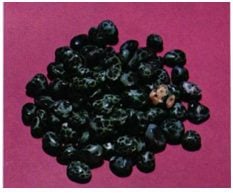Pumpellyite Value, Price, and Jewelry Information
The gem variety of pumpellyite, chlorastrolite, is best known from the Lake Superior district of the United States. It typically forms aggregates of packed fibers that are mixed with other minerals, resulting in a green and white pattern reminiscent of tortoise shell. The effect is best observed when the fibers are in radial clusters that yield circular markings.
1 Minute Read
The gem variety of pumpellyite, chlorastrolite, is best known from the Lake Superior district of the United States. It typically forms aggregates of packed fibers that are mixed with other minerals, resulting in a green and white pattern reminiscent of tortoise shell. The effect is best observed when the fibers are in radial clusters that yield circular markings.
Start an IGS Membership today
for full access to our price guide (updated monthly).Pumpellyite Value
PUMPELLYITE (= CHLORASTROLITE) Also note:
Ferropumpellyite: contains ferrous iron. Julgolditet: contains both ferric and ferrous iron.
Optics: a=1.674-1.702; β=1.675-1.715; γ= 1.688-1.722.
Biaxial (+) and (-), 2V: 26—85°. May show anomalous birefringent colors. Mean index ~ 1.7.
Occurrence: Pumpellyite occurs in a wide variety of igneous and metamorphic rocks and environments.
Scotland; Austria; Finland; USSR; New Zealand; South Africa; other localities,
Calumet, Michigan: in copper ores; also at Isle Royale.
Lake Superior, Michigan (non-gem) and on the Keweenaw Peninsula, Michigan (non-gem).
Lake Superior: basic igneous rocks on the periphery of the lake contain spherical aggregates of green fibers of chlorastrolite, in masses. This material is sometimes cut but is not homogeneous.
California: in glaucophane schists.
New Jersey: in basalts (traprocks).
Comments: The gem variety of pumpellyite, chlorastrolite, is best known from the Lake Superior district of the United States. It typically forms aggregates of packed fibers that are mixed with other minerals, resulting in a green and white pattern reminiscent of tortoise shell. The effect is best observed when the fibers are in radial clusters that yield circular markings. The turtle-back pattern is considered most desirable and. because of the chatoyancy of the fibers, seems to move within the stone as the lighting is changed. Pumpellyite is a common mineral in many parts of the world, but fine green material is scarce and greatly prized by collectors. The best color is a very intense green resembling the color of fine emerald or Imperial jade. Good-quality chlorastrolite with strong pattern and color is now difficult to obtain.
Name: Pumpellyite after Raphael Pumpelly, Michigan geologist who did pioneering studies of the Keweenaw Peninsula copper district of Michigan. Chlorastrolite is from Greek words meaning green star stone.
Joel E. Arem, Ph.D., FGA
Dr. Joel E. Arem has more than 60 years of experience in the world of gems and minerals. After obtaining his Ph.D. in Mineralogy from Harvard University, he has published numerous books that are still among the most widely used references and guidebooks on crystals, gems and minerals in the world.
Co-founder and President of numerous organizations, Dr. Arem has enjoyed a lifelong career in mineralogy and gemology. He has been a Smithsonian scientist and Curator, a consultant to many well-known companies and institutions, and a prolific author and speaker. Although his main activities have been as a gem cutter and dealer, his focus has always been education. joelarem.com
Related Articles
Black Diamond Value, Price, and Jewelry Information
Chameleon Diamond Value, Price, and Jewelry Information
Gray Diamond Value, Price, and Jewelry Information
Green Diamond Value, Price, and Jewelry Information
Latest Articles
800 Years of Mogok: A Celebration in Tenuous Times
What is the Average Gemstone Faceting Yield?
Pyroxmangite Value, Price, and Jewelry Information
How to Identify Emerald Simulants and Synthetics
Never Stop Learning
When you join the IGS community, you get trusted diamond & gemstone information when you need it.
Get Gemology Insights
Get started with the International Gem Society’s free guide to gemstone identification. Join our weekly newsletter & get a free copy of the Gem ID Checklist!
